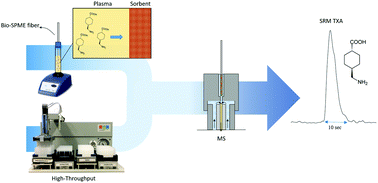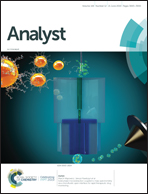Solid phase microextraction coupled to mass spectrometry via a microfluidic open interface for rapid therapeutic drug monitoring†
Abstract
Tranexamic acid (TXA) is an antifibrinolytic used during cardiac surgery that presents high inter-patient variability. High plasma concentrations have been associated with post-operative seizures. Due to the difficulties with maintaining acceptable concentrations of TXA during surgery, implementation of a point-of-care strategy for testing TXA plasma concentration would allow for close monitoring of its concentration during administration. This would facilitate timely corrections to the dosing schedule, and in effect tailor treatment for individual patient needs. In this work, a method for the rapid monitoring of TXA from plasma samples was subsequently carried out via biocompatible solid-phase microextraction (Bio-SPME) coupled directly to tandem mass spectrometry via a microfluidic open interface (MOI). MOI operates under the concept of a flow-isolated desorption volume and was designed with aims to directly hyphenate Bio-SPME to different detection and ionization systems. In addition, it allows the desorption of Bio-SPME fibers in small volumes while it concurrently continues feeding the ESI with a constant flow to minimize cross-talking and instabilities. The methodology was used to monitor six patients with varying degrees of renal dysfunction, at different time points during cardiac surgery. MOI proves to be a reliable and feasible tool for rapid therapeutic drug monitoring. Affording total times of analysis as low as 30 seconds per sample in its high throughput mode configuration while the single sample turn-around time was 15 minutes, including sample preparation. In addition, cross-validation against a standard thin film solid phase microextraction using liquid chromatography coupled to tandem mass spectrometry (TFME-LC-MS/MS) method was performed. Bland–Altman analysis was used to cross-validate the results obtained by the two methods. Data analysis demonstrated that 92% of the compared data pairs (n = 63) were distributed within the acceptable range. The data was also validated by the Passing Bablok regression, demonstrating good statistical agreement between these two methods. Finally, the currently presented method offers comparable results to the conventional liquid chromatography with acceptable RSDs, while only necessitating a fraction of the time. In this way, TXA concentration in plasma can be monitored in a close to real time throughput during surgery.



 Please wait while we load your content...
Please wait while we load your content...